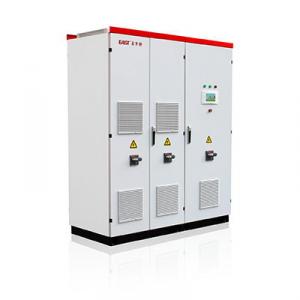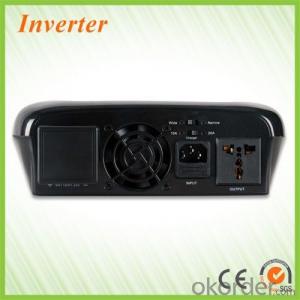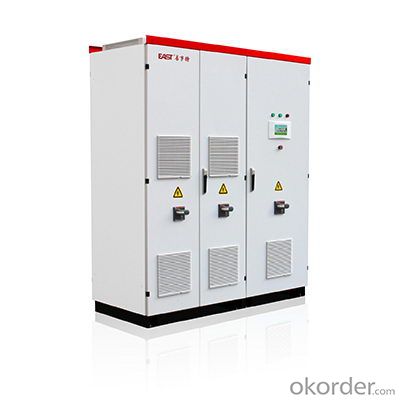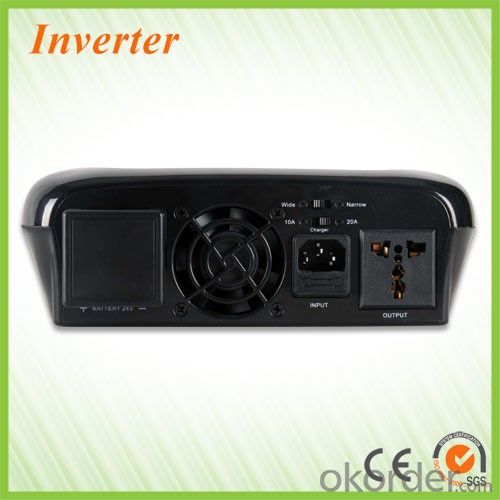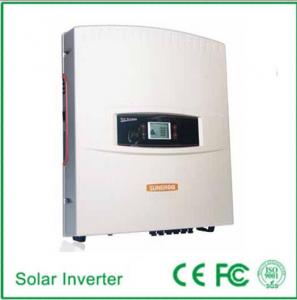Amazon Solar Inverter EA500KTL/H - Wider Input Voltage Range and Higher Efficiency On-Grid PV Central Inverter
- Loading Port:
- China main port
- Payment Terms:
- TT or LC
- Min Order Qty:
- 1 pc
- Supply Capability:
- 1000 pc/month
OKorder Service Pledge
OKorder Financial Service
You Might Also Like
EA500KTL/H
EA500KTF is designed with external isolation transformer. It has wider input voltage range and higher efficiency. Moreover, optical fiber isolation technology has been adopted to increase its anti-interference ability. Complete protection, higher MPPT efficiency, simple monitoring and capability of parallel operation make it ideal for large scale PV power plant.
● Maximum efficiency up to 98.7% (without transformer)
● Effective IGBT module
● Wide MPPT range, convenient for module configuration
● With DSP + CPLD digital control technology, having complete protection, safe and reliable
● Advanced MPPT (Maximum Power Point Tracking) algorithms
● Advanced Anti-islanding technology
● Efficient thermal system design, suitable for critical PV applications
● Multilingual LCD, easy to operate
● Integrated multi-communication interfaces, easy to monitor
● Low voltage ride through function
● For large centralized power plant connecting to high-voltage grid (with external step-up transformer)
● Active and reactive power regulation function (optional)
● TÜV CE, CQC certification
Specification / Type | EA500KTL | EA500KTH |
Input (DC) | ||
Max DC Voltage | 1000Vdc | |
Full-load MPPT Voltage Range | 450~820Vdc | |
Max DC Power | 550KWp | |
Max DC Current | 1200A | 1100A |
Number of DC Inputs | 16 | 16 |
Output (AC) | ||
Nominal AC Power | 500KW | |
Nominal AC Voltage | 270Vac | 350Vac |
AC Voltage Range | 210~310Vac | 245~362Vac |
Nominal Frequency | 50Hz/60Hz | |
Frequency Tolerance Range | 47-51.5Hz/57-61.5Hz | |
Distortion (THD%) | <3%(at nominal power) | |
Power Factor (Cos phi) | 0.9(leading)~0.9(lagging) | |
System Parameters | ||
Max Efficiency | 98.7% | |
Euro Efficiency | 98.5% | |
Protection Degree | IP20 (indoor) | |
Night Consumption | <100W | |
Operation Temperature Range | -25℃~+55℃ | |
Cooling | forced-air cooling | |
Relative Humidity | 0-95%, no condensation | |
Max Working Altitude | 2000m (derating above 3000m) | |
Display and Communication | ||
Display | LCD | |
Standard Communication | RS485 | |
Optional Communication | Ethernet /USB | |
Structure Parameters | ||
Dimensions(W×D×H) | 1800×800×2200mm | 1800×800×2200mm |
Weight | 1500kg | 1500kg |
· Q. What is an UPS and What it is for ?
An uninterruptible power supply (UPS) is a device that allows your computer or telephone switch or critical equipement to keep running for at least a short time or longer time when the primary power source is lost. It also provides protection from power surges, spikes, brownouts, interference and other unwanted problems on the supported equipment.
· Q. How long the UPS to run when power goes?
This can take 3 paths.
1.You can pick a UPS that is rated for pretty much the full VA you need so it will be running at 100% of capability and will thus last 'n' minutes.
2.You can pick a UPS that is rated at a much higher VA value than you really need so, for example, is running at 50% of capability and will thus last for longer than the UPS from option 1.
3.You can use extra external battery packs to run for longer. If charging capability allows, the more and the bigger batteries you take with, the longer time UPS runs.
or using a generator after about 6 hours, it will be more cost-effective, with a short runtime UPS to bridge the generator start-up gap.
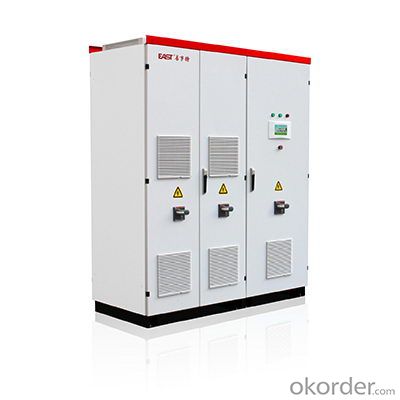

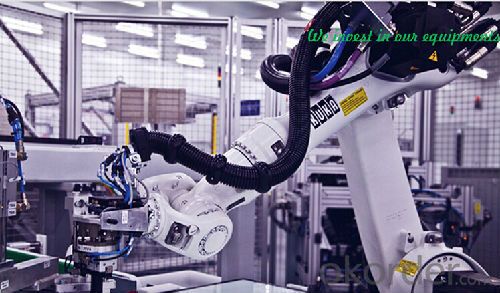
- Q: How does a solar inverter handle variations in temperature?
- A solar inverter is designed to handle variations in temperature by incorporating temperature sensors and thermal management systems. These sensors monitor the temperature of the inverter and its components, allowing it to adjust its operations accordingly. The inverter's thermal management system helps dissipate excess heat and prevent overheating, ensuring optimal performance and longevity. Additionally, advanced inverters may have temperature compensation algorithms that adjust the voltage and power output to compensate for the temperature changes, maximizing energy production.
- Q: How does a solar inverter handle anti-islanding protection?
- A solar inverter handles anti-islanding protection by continuously monitoring the grid's voltage and frequency. If the grid's voltage or frequency deviates from the predetermined range, indicating a potential islanding condition, the inverter quickly disconnects from the grid to prevent energy flow. This ensures the safety of utility workers and prevents damage to the electrical grid.
- Q: How does a solar inverter affect the overall aesthetics of a solar installation?
- A solar inverter does not have a direct impact on the overall aesthetics of a solar installation as it is typically installed indoors or in a separate enclosure. The inverter's primary function is to convert the DC electricity generated by the solar panels into usable AC electricity for consumption. However, it is important to choose an inverter that is compatible with the installation's design and size to ensure efficient operation and minimal visual impact.
- Q: How does a solar inverter protect against overvoltage and overcurrent?
- A solar inverter protects against overvoltage by constantly monitoring the voltage level of the solar panels. If the voltage exceeds a predetermined threshold, the inverter will automatically reduce the power output or shut down to prevent damage. Similarly, to protect against overcurrent, the inverter continuously monitors the current flowing through the system. If the current surpasses a safe limit, the inverter will limit the output or shut down to prevent overheating and potential hazards.
- Q: What is the PV inverter starting voltage
- sine wave becomes narrower and the voltage width in the center of the sine wave is widened and the switching element is always operated in a direction at a certain frequency in a half cycle, A pulse wave train (pseudo sine wave). Then let the pulse wave form a sine wave through a simple filter
- Q: How does a solar inverter protect against overvoltage or overcurrent?
- A solar inverter protects against overvoltage or overcurrent by continuously monitoring the voltage and current levels of the solar panels. If it detects an excessive voltage or current, it automatically disconnects the panels from the grid to prevent any damage. Additionally, the inverter may also have built-in protective devices like surge suppressors or fuses to further safeguard against overvoltage or overcurrent situations.
- Q: Can a solar inverter be used in regions with high altitude conditions?
- Yes, a solar inverter can be used in regions with high altitude conditions. However, it is important to consider certain factors such as temperature variations, reduced air density, and increased UV radiation at higher altitudes. In such cases, it may be necessary to choose a solar inverter specifically designed to handle these conditions and ensure proper functioning and efficiency of the system.
- Q: What are the key factors affecting the reliability of a solar inverter?
- The key factors affecting the reliability of a solar inverter include the quality and durability of its components, such as the semiconductor devices, capacitors, and transformers. The design and manufacturing processes also play a significant role, as well as the overall system integration and installation. The environmental conditions, such as temperature, humidity, and dust levels, can impact the inverter's reliability, along with the quality of the electrical grid and the stability of the solar power generation. Regular maintenance and monitoring are crucial for identifying and addressing any potential issues that may arise, ensuring the long-term reliability of the solar inverter.
- Q: Can a solar inverter be repaired or replaced if it malfunctions?
- Yes, a solar inverter can be repaired or replaced if it malfunctions. In many cases, minor issues can be repaired by a qualified technician, while more severe malfunctions may require the replacement of the inverter. The specific course of action will depend on the nature and extent of the malfunction, as well as the warranty and service options provided by the manufacturer.
- Q: Are there any safety considerations when installing a solar inverter?
- Yes, there are several safety considerations when installing a solar inverter. Firstly, it is important to ensure that the inverter is installed by a qualified professional who is familiar with local electrical codes and regulations. This helps to minimize the risk of electrical hazards and ensures a safe installation. Additionally, proper grounding and bonding should be implemented to protect against electrical shock and lightning strikes. Adequate ventilation and temperature management are also important to prevent overheating and potential fire hazards. Overall, following safety guidelines and employing professional installation services are crucial to ensure the safe and efficient operation of a solar inverter system.
Send your message to us
Amazon Solar Inverter EA500KTL/H - Wider Input Voltage Range and Higher Efficiency On-Grid PV Central Inverter
- Loading Port:
- China main port
- Payment Terms:
- TT or LC
- Min Order Qty:
- 1 pc
- Supply Capability:
- 1000 pc/month
OKorder Service Pledge
OKorder Financial Service
Similar products
Hot products
Hot Searches
Related keywords
